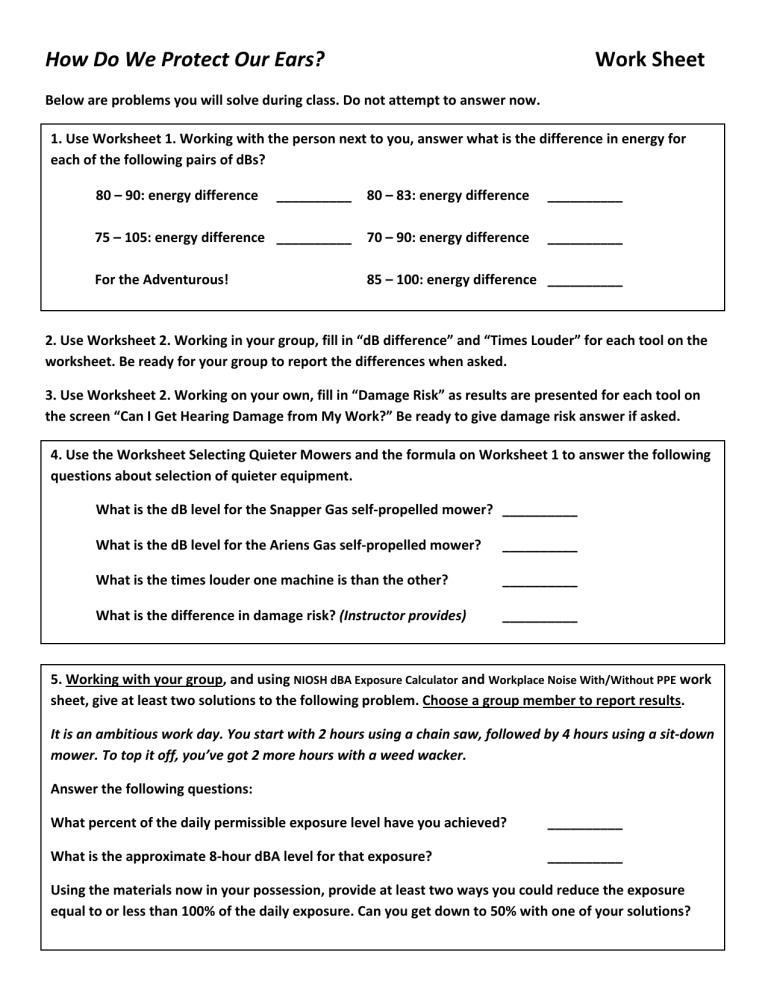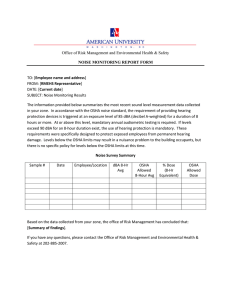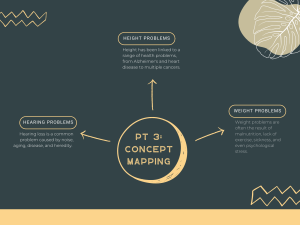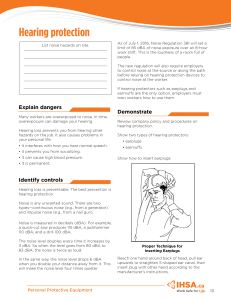
How Do We Protect Our Ears? Work Sheet Below are problems you will solve during class. Do not attempt to answer now. UseWorksheet Worksheet1.1.Working Workingwith withthe theperson personnext nextto toyou, you,answer answerwhat whatisisthe thedifference differenceininenergy energyfor foreach 1.1.Use the following pairs ofeach the of following pairs of dBs?of dBs? 80––90: 90:energy energydifference difference__________ __________ 80 80––83: 83:energy energydifference difference__________ __________ 80 75––105: 105:energy energydifference difference__________ __________ 70 70––90: 90:energy energydifference difference__________ __________ 75 Forthe theAdventurous! Adventurous! For 85––101: 100:energy energydifference difference__________ __________ 85 2. Use Worksheet 2. Working in your group, fill in “dB difference” and “Times Louder” for each tool on the worksheet. Be ready for your group to report the differences when asked. 3. Use Worksheet 2. Working on your own, fill in “Damage Risk” as results are presented for each tool on the screen “Can I Get Hearing Damage from My Work?” Be ready to give damage risk answer if asked. 4. Use the Worksheet Selecting Quieter Mowers and the formula on Worksheet 1 to answer the following questions about selection of quieter equipment. What is the dB level for the Snapper Gas self‐propelled mower? __________ What is the dB level for the Ariens Gas self‐propelled mower? __________ What is the times louder one machine is than the other? __________ What is the difference in damage risk? (Instructor provides) __________ 5. Working with your group, and using NIOSH dBA Exposure Calculator and Workplace Noise With/Without PPE work sheet, give at least two solutions to the following problem. Choose a group member to report results. It is an ambitious work day. You start with 2 hours using a chain saw, followed by 4 hours using a sit‐down mower. To top it off, you’ve got 2 more hours with a weed wacker. Answer the following questions: What percent of the daily permissible exposure level have you achieved? __________ What is the approximate 8‐hour dBA level for that exposure? __________ Using the materials now in your possession, provide at least two ways you could reduce the exposure equal to or less than 100% of the daily exposure. Can you get down to 50% with one of your solutions? How Do We Protect Our Ears? Worksheet #1 NOISE ENERGY Measure dBs Cut or tear along the dotted line. Align marks with dBs on scale to estimate dB increases 2 to 1,000 times greater. dBs ENERGY* 130 10,000,000,000,000 120 1,000,000,000,000 110 100,000,000,000 100 10,000,000,000 90 1,000,000,000 80 100,000,000 70 10,000,000 60 1,000,000 50 100,000 3. Use the result as the exponent of 2 40 10,000 For example, how much more energy is 96dB than . is 81 dB? 30 1,000 20 100 10 10 0 1 1 ,0 0 0 X 100X 10X 2X For The Adventurous! Use the formula below to figure size difference of any two dBs 1. Subtract smaller dB from larger dB 85 2. Divide answer by 3 1. 96 - 81 = 15 2. 15/3 = 5 3. 2 = 2 x 2 x 2 x 2 x 2 = 32 96 dB has 32 times more energy than 81 dB. Daily Exposure to Noise Above 85 dB is harmful. *Relationship sound Energy in dBs and in Watts/Meter 2 from 10-12 to 10 13 FOF How Do We Protect Our Ears? Worksheet #2 Equipment Equipment dB How Much Damage Preferred* dB Risk dB Difference Louder 105 dB 80 dB 112 dB 80 dB 102 dB 80 dB 101 dB 80 dB 88 dB 80 dB 89 dB 80 dB 94 dB 80 dB 91 dB 80 dB 100 dB 80 dB 90 dB 80 dB *NIOSH recommends keeping exposures at or below 80 dB. NIOSH has determined that daily exposures above 85 dB may be harmful to health. OSHA uses 85 dB as the “action level” at which an employer must establish a Hearing Protection Plan. FOF How Do We Protect Our Ears? Selecting Quieter Mowers. The table below provides brand, model, published price, and noise levels of mowers. For noise levels for the operator above 85 dBA (color code red), hearing protection must be offered and worn. Between 80 and 85 dBA, hearing protection is advisable if your exposure is unusually long, or if you engage in other loud activities throughout the day. For noise under 82 dBA, hearing protection is not required but may be used. H earing Protection is n ot required but m ay be u sed. Brand Type McLane* Brill/Sun Lawn Brill/Sun Lawn* Silent Reel Neuton* American Yard Machines Black & Decker* Electric Ox Black & Decker* Ariens* Honda* Bolens* Toro* Murray* Craftsman* Murray* Craftsman* Toro* Craftsman* Craftsman* Craftsman* Yard-Man* Yard-Man* Lawn-Boy* MTD* Craftsman* Bolens* Yard-Man* Craftsman* Troy-Bilt* Yard-Man* Bolens* Husqvarna* Snapper* Snapper* Husqvarna* Reel Mower17" Reel Mower Cordless Elec Reel Reel Mower Electric-Cordless Reel Mower Electric-Corded Electric-Cordless Electric Riding Electric-Corded Gas-Self Prop Gas-Self Prop Electric-corded Gas-Self Prop Gas-Push Gas-Self Gas-Self Prop Gas-Push Gas-Push Gas-Self Prop Gas-Self Prop Gas-Self Prop Gas-Self Prop Gas-Self Prop Gas-Self Prop Gas-Push Pro Gas-Push Gas-Push Gas-Self Prop Gas-Self Prop Gas-Self Prop Gas-Push Gas-Push Gas-Self Prop Gas-Self Prop Gas-Push Gas-Self Prop H earing P r otection R ecom m ended.. Model Front Throw Luxus 38 380 ASM EM 4.1 13 inch CMM 1000 MM875 911097 HRX217HXA 18A-V17-765 PP Recycler 20031 225112X92A 37910 226111X92A 38746 20008 37778 37855 37784 12A978Q 12A445E755 Gold Series 10655 11A588Q 38855 11A-584E765 DLX 12A567A 37894 TuffCut 230 11A435D775 11A084C163 55R21HV RP215517HC MR216517B 5521CHV Price $200 $200 $350 $249 $400 $130 $200 $464 $7,500 $244 $470 $700 $190 $420 $155 $280 $215 $200 $350 $330 $330 $400 $400 $260 $400 $200 $229 $170 $300 $280 $400 $190 $170 $480 $660 $410 $350 Data sources: Noise Pollution Clearinghouse and Consumer Reports *Evaluated by Consumer Reports in the June 2004 issue H earing Protection m ust be o ffered and w orn. Noise @ Noise @ Operator 25 feet 63 68 68 74 77 76 79 79 82 80 82 84 85 85 84 84 85 86 86 86 86 85 85 87 87 88 89 89 88 88 89 89 88 86 91 90 91 54 55 56 58 59 60 60 62 63 64 72 74 74 74 75 75 75 75 75 75 75 76 76 76 76 76 74 76 77 77 77 77 77 78 63 80 82 # of 60 dBA Electric Mowers to which noise is equivalent 0.25 0.31 0.40 0.63 0.79 1.00 1.00 1.59 2.00 2.52 17.00 27.00 27.00 28.00 30.00 30.00 34.00 32.00 34.00 34.00 35.00 37.00 38.00 38.00 38.00 38.00 34.00 41.00 49.00 50.00 50.00 50.00 53.00 57.00 80.00 102.00 150.00 FOF How Do We Protect Our Ears? Selecting Quieter Chain Saws. Rank how well saw cut DBA 80 81 82 83 84 85 86 87 88 89 90 91 92 93 94 95 96 97 98 99 100 101 102 103 104 105 106 107 108 109 110 111 112 113 114 115 .50 1.0 1.3 1.6 2.0 2.5 3.2 4.0 5.0 6.4 8.0 10.8 12.7 16.0 20.1 25.4 32.0 40.3 50.8 64.0 80.6 101.6 128.0 161.3 203.2 256.0 322.5 406.0 512.0 645.1 812.8 1024.0 1290.1 1625.5 2048.0 2580.3 3251.0 1 2.0 2.5 3.2 4.0 5.0 6.3 8.0 10.1 12.7 16.0 20.2 25.4 32.0 40.3 50.8 64.0 80.6 101.6 128.0 161.3 203.2 256.0 322.5 406.4 512.0 645.1 812.7 1024.0 1290.2 1625.5 2048.0 2580.3 3251.0 4096.0 5160.6 6502.0 2 4.0 5.0 6.3 8.0 10.1 12.7 16.0 20.2 25.4 32.0 40.3 50.8 64.0 80.6 101.6 128.0 161.3 203.2 256.0 322.5 406.4 512.0 645.1 812.7 1024.0 1290.2 1625.5 2048.0 2580.3 3251.0 4096.0 5160.6 6502.0 8192.0 10321.3 13004.0 60.5 76.2 96.0 121.0 152.4 192.0 241.9 304.8 384.0 483.8 609.6 768.0 967.6 1219.1 1536.0 1935.2 2438.2 3072.0 3870.5 4876.5 6144.0 7741.0 9753.0 12288.0 15481.9 19506.0 3 6.0 7.6 9.5 12.0 15.1 19.0 24.0 30.2 38.1 48.0 4 8.0 10.1 12.7 16.0 20.2 25.4 32.0 40.3 50.8 64.0 80.6 101.6 128.0 161.3 203.2 256.0 322.5 406.4 512.0 645.1 812.7 1024.0 1290.2 1625.5 2048.0 2580.3 3251.0 4096.0 5160.6 6502.0 8192.0 10321.3 13004.0 16384.0 20642.5 26008.0 Protection not required but may be used. .25 .5 .7 .8 1.0 1.3 1.6 2.0 2.5 3.2 4.0 5.4 6.4 8.0 10.5 12.7 16.0 20.1 25.4 32.0 40.3 50.8 64.0 80.6 101.6 128.0 161.3 203.2 256.0 322.5 406.4 512.0 645.1 812.7 1024.0 1290.2 1625.4 dBA Exposure Calculator 5 10.0 12.6 15.9 20.0 25.2 31.7 40.0 50.4 63.5 80.0 100.8 127.0 160.0 201.6 254.0 320.0 403.2 508.0 640.0 806.3 1015.9 1280.0 1612.7 2031.9 2560.0 3225.4 4063.7 5120.0 6450.8 8127.5 10240.0 12901.6 16255.0 20480.0 25803.2 32510.0 6 12.0 15.1 19.0 24.0 30.2 38.1 48.0 60.5 76.2 96.0 121.0 152.4 192.0 241.9 304.8 384.0 483.8 609.6 768.0 967.6 1219.1 1536.0 1935.2 2438.2 3072.0 3870.5 4876.5 6144.0 7741.0 9753.0 12288.0 15481.9 19506.0 24576.0 30963.8 39012.0 Hours 7 14.0 17.6 22.2 28.0 35.3 44.4 56.0 70.6 88.9 112.0 141.1 177.8 224.0 282.2 355.6 448.0 564.4 711.2 896.0 1128.9 1422.3 1792.0 2257.8 2844.6 3584.0 4515.6 5689.2 7168.0 9031.1 11378.5 14336.0 18062.2 22757.0 28672.0 36124.5 45514.0 8 16.0 20.2 25.4 32.0 40.3 50.8 64.0 80.6 101.6 128.0 161.3 203.2 256.0 322.5 406.4 512.0 645.1 812.7 1024.0 1290.2 1625.5 2048.0 2580.3 3251.0 4096.0 5160.6 6502.0 8192.0 10321.3 13004.0 16384.0 20642.5 26008.0 32768.0 41285.1 52016.0 9 18.0 22.7 28.6 36.0 45.4 57.1 72.0 90.7 114.3 144.0 181.4 228.6 288.0 362.9 457.2 576.0 725.7 914.3 1152.0 1451.4 1828.7 2304.0 2902.9 3657.4 4608.0 5805.7 7314.7 9216.0 11611.4 14629.5 18432.0 23222.9 29259.0 36864.0 46445.7 58518.0 Protection is recommended. 10 20.0 25.2 31.7 40.0 50.4 63.5 80.0 100.8 127.0 160.0 201.6 254.0 320.0 403.2 508.0 640.0 806.3 1015.9 1280.0 1612.7 2031.9 2560.0 3225.4 4063.7 5120.0 6450.8 8127.5 10240.0 12901.6 16255.0 20480.0 25803.2 32510.0 40960.0 51606.4 65019.9 11 22.0 27.7 34.9 44.0 55.4 69.8 88.0 110.9 139.7 176.0 221.7 279.4 352.0 443.5 558.8 704.0 887.0 1117.5 1408.0 1774.0 2235.1 2816.0 3547.9 4470.1 5632.0 7095.9 8940.2 11264.0 14191.8 17880.5 22528.0 28383.5 35761.0 45056.0 56767.0 71521.9 12 24.0 30.2 38.1 48.0 60.5 76.2 96.0 121.0 152.4 192.0 241.9 304.8 384.0 483.8 609.6 768.0 967.6 1219.1 1536.0 1935.2 2438.2 3072.0 3870.5 4876.5 6144.0 7741.0 9753.0 12288.0 15481.9 19506.0 24576.0 30963.8 39012.0 49152.0 61927.6 78023.9 13 26.0 32.8 41.3 52.0 65.5 82.5 104.0 131.0 165.1 208.0 262.1 330.2 416.0 524.1 660.4 832.0 1048.3 1320.7 1664.0 2096.5 2641.4 3328.0 4193.0 5282.9 6656.0 8386.0 10565.7 13312.0 16772.1 21131.5 26624.0 33544.1 42263.0 53248.0 67088.3 84525.9 14 28.0 35.3 44.4 56.0 70.6 88.9 112.0 141.1 177.8 224.0 282.2 355.6 448.0 564.4 711.2 896.0 1128.9 1422.3 1792.0 2257.8 2844.6 3584.0 4515.6 5689.2 7168.0 9031.1 11378.5 14336.0 18062.2 22757.0 28672.0 36124.5 45514.0 57344.0 72248.9 91027.9 15 30.0 37.8 47.6 60.0 75.6 95.2 120.0 151.2 190.5 240.0 302.4 381.0 480.0 604.8 762.0 960.0 1209.5 1523.9 1920.0 2419.0 3047.8 3840.0 4838.1 6095.6 7680.0 9676.2 12191.2 15360.0 19352.4 24382.5 30720.0 38704.8 48765.0 61440.0 77409.5 97529.9 Protection must be offered and worn. % of 100% exposures, based on NIOSH 3dBA doubling 85 dBA NIOSH level for PPE use corresponds to OSHA 85 dBA action Level in landcare industries OHSA requires exposure control, which may include PPE, at 85 dBA for an 8-hour TWA Sound Advice How Do We Protect Our Ears? Ear Protection Selection Guide Workplace Noise With and Without PPE Your daily exposure to occupational noise helps determine your risk of hearing loss. Generally, the higher the decibels, the greater the risk. OSHA’s noise standard for landcare is 85 dB (decibels) over an 8-hour workday. 80 dB is the standard recommended by the National Institute for Occupational Safety and Health (NIOSH). At OSHA’s level, 25 in every 100 workers will experience hearing loss over a working lifetime. At the NIOSH level of 80 dB in 8 hours, only 3 or 4 of every 100 workers will experience hearing loss over a working lifetime. The table displays dBs for common equipment of the land care industry with various types of hearing protection. Find equipment you use and see how hearing protection reduces the dBs. Tools/Equipment No Protection Formable Plugs Foam Plugs Muffs Muffs+ Plugs Air Compressor 92 dB 84 dB 79 dB 73 dB 67 dB Background Noise 83 dB 75 dB 70 dB 64 dB 58 dB Grinder 4 ¼ ” Hammer Drill ¼ ” bit 93 dB 94 dB 85 dB 86 dB 80 dB 81 dB 74 dB 75 dB 68 dB 69 dB Bob Cat S850 (operator) Bob Cat S850 (outside) 88 dB 104 dB 80 dB 96 dB 75 dB 91 dB 69 dB 85 dB 63 dB 79 dB Chain Saw (battery) Chain Saw (gas) Demo Saw 14” (gas) Hedge Trimmer (gas) 92 dB 112 dB 113 dB 88 dB 84 dB 104 dB 105 dB 80 dB 79 dB 99 dB 100 dB 75 dB 73 dB 93 dB 94 dB 69 dB 67 dB 87 dB 88 dB 63 dB Leaf Blower Hand Held 102 dB 94 dB 89 dB 83 dB 77 dB Leaf Blower Backpack Leaf Vacuum w Tractor 104 dB 104 dB 96 dB 96 dB 91 dB 91 dB 85 dB 85 dB 79 dB 79 dB Mower Ride On (electric) Mower Ride On (gas) Mower Stand On (gas) 82 dB 94 dB 94 dB 74 dB 86 dB 86 dB 69 dB 81 dB 81 dB 63 dB 75 dB 75 dB 57 dB 69 dB 69 dB Mower Walk Behind (gas) Mulcher (gas) 88 dB 91 dB 80 dB 83 dB 75 dB 78 dB 69 dB 73 dB 63 dB 67 dB Oxyacetylene Cutting 81 dB 73 dB 68 dB 62 dB 56 dB Weed Whacker 100 dB 92 dB 87 dB 81 dB 75 dB Wood Chipper 105 dB 97 dB 92 dB 86 dB 80 dB The values in Column 2 are based on noise measurements from a variety of manufacturer and researcher sources. The values for each type of hearing protection are based on Noise Reduction Rating formulas developed by the National Institute for Occupational Safety and Health (NIOSH). Neither of these measurements may accurately reflect your noise exposures or protection factors. These depend on workplace monitoring of workers and the effectiveness of your employer’s hearing protection program. FOF How Do We Protect Our Ears? Ear Protection Selection Guide Step-by-step guidelines for selecting appropriate hearing protection What is full-day average noise exposure?(TWA8) <85 dBA 85 to 95 dBA Do employees ever work in situations where noise levels are 85 dBA or higher? Do employees ever work in situations where noise levels are 95 dBA or higher? No Yes No 95 to 105 dBA Yes Do employees spend... More than 15 minutes, in total, where noise levels are 95 to 105 dBA? OR Any time where noise levels are 105 dBA or louder? >=105 dBA Yes No Situations where noise levels are under 85 dBA Situations where noise levels are 85 to 95 dBA Use no protection OR Use low NRR (optional) Use low or mid NRR. Mid NRR is preferred when noise levels are 90 to 95 dBA Situations where noise levels are 95 to 105 dBA— up to 15 minutes OK for employees with short exposures to use the same low or mid NRR protector they would use in other, less noisy situations All other situations where noise levels are 95 dBA or louder LIMIT EXPOSURE TIME! “very loud noise” See Item 2 next page How Do We Protect Our Ears? Ear Protection Selection Guide 1. Guidelines for choosing hearing protection Noise level (dBA) Signal words Hearing protection Comments 115 or higher Level A Danger Use double protection or maybe high NRR 1,2 High NRR can be OK for short exposures Level B Danger Use high NRR or maybe double protection Mid NRR can be OK for short exposures Level C Warning Use high NRR 105 to 115 95 to 105 (less than 15 minutes)3 (less than 15 minutes)3 Low or mid NRR can be OK for short exposures (less than 15 minutes)3 85 to 95 Level D Caution Do not over-protect Use low or mid NRR Mid NRR is better than low, if noise levels are usually 90 to 95 dBA Under 85 Level E Notice Hearing protection is optional Low NRR is adequate for optional use 2. Guidelines for choosing hearing protection for very loud noise! If the total amount of time spent in very loud noise during one day is... 1 hour or longer 15 minutes to 1 hour No more than 15 minutes Level A 115 dBA or higher Use double protection 1 Use double protection Use high NRR Level B 105 to 115 dBA Use double protection Use high NRR Consider double protection Mid NRR can be OK 3 Level C 95 to 105 dBA Use high NRR Consider double protection 2 Mid NRR can be OK Low NRR can be OK protection 3 3 1 Double protection = ear muffs plus ear plugs, together 2 Noise Reduction Rating (NRR): Low NRR < 17 dB; Mid NRR 17-24 dB; High NRR 24+ dB 3 It is OK to use the lower level of protection shown in the figure if... a The total amount of time and the typical noise levels are not both in the upper end of the range shown on previous page b Exposure occurs as brief exposures spread out over the work shift and not continuously or within a short period of time c The situation does not involve a lot of impact noise d The employee will not be exposed to noise for a large part of the rest of the shift. How To Wear Soft Foam Earplugs To get the best protection from your soft foam earplugs, remember to roll , pull , and hold when putting them in. Use clean hands to keep from getting dirt and germs into your ears! 1. Roll the earplug up into a small, thin "snake" with your fingers. You can use one or both hands. 2. Pull the top of your ear up and back with your opposite hand to straighten out your ear canal. The rolled-up earplug should slide right in. 3. Hold the earplug in with your finger. Count to 20 or 30 out loud while waiting for the plug to expand and fill the ear canal. Your voice will sound muffled when the plug has made a good seal. Check the fit when you're all done. Most of the foam body of the earplug should be within the ear canal. Try cupping your hands tightly over your ears. If sounds are much more muffled with your hands in place, the earplug may not be sealing properly. Take the earplug out and try again. http://www.cdc.gov/niosh/mining/topics/hearingloss/earplug.htm





